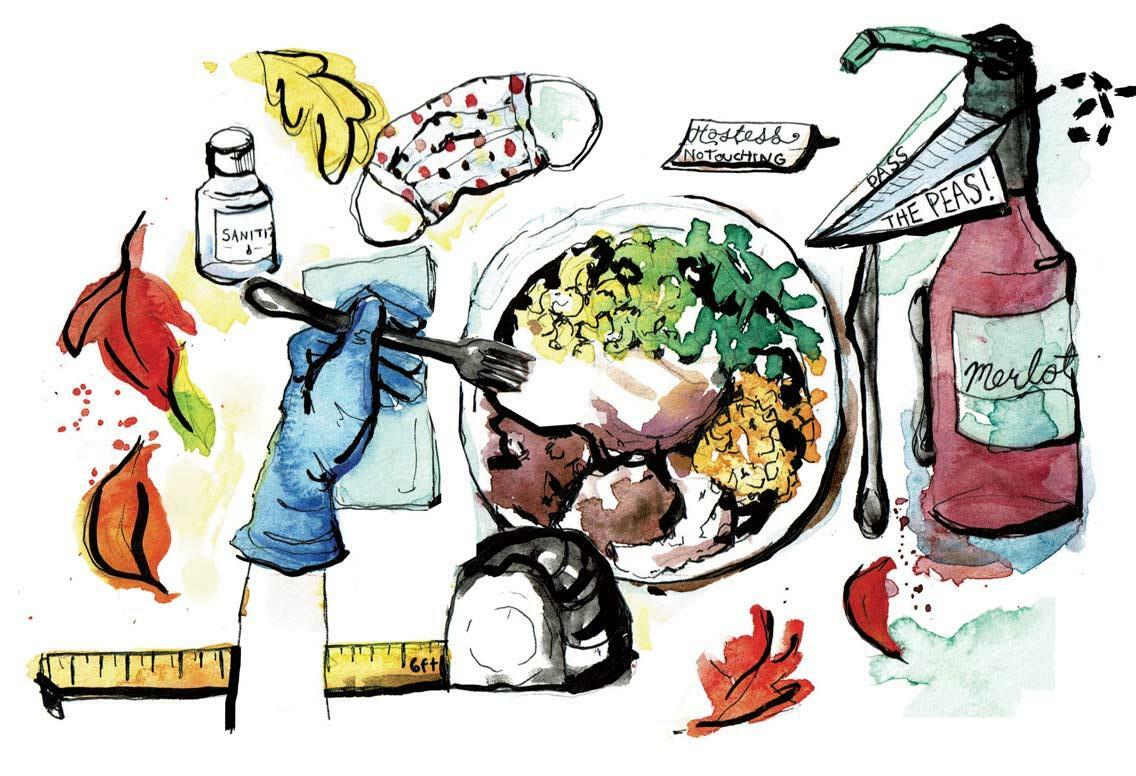
46 minute read
NOTED: The COVID-Free Feast
NOTED
The COVID-Free Feast
Advertisement
Katherine Snow Smith, author of Rules for the Southern Rulebreaker: Missteps and Lessons Learned, shares her tips for hosting Thanksgiving in a pandemic.
illustrations by JILLIAN OHL
Afriend of mine recently told me she was expecting 20 people to come over for Thanksgiving. “Thanksgiving?” I replied, “Are we really doing that this year?”
Turns out, yes: most folks are gathering. Entertaining during a pandemic seems to have gone from oxymoron, to something only morons would do, to an acceptable social experiment—if proper precautions are taken.
Naturally, lessons have been learned along the way.
Early in the pandemic, I hosted an Easter brunch in my backyard. Two of my three children were there, along with my former husband and my former motherin-law. Erring on the side of social distancing (and my sanity), I told my ex-husband that I thought he, the kids and I should spread out at my round wrought iron table, with his mom set up at a separate card table—she’s in her 80s and has some
respiratory issues, after all. He agreed. Placing said card table in the garage while we were on the deck proved a much harder sell. As a compromise, his mom landed on the lawn, about eight feet from the rest of us. I spruced up her satellite location with a vase of fresh flowers, a personal pitcher of water and individual condiments. Conversation still flowed easily between tables, with considerably less micromanaging from the oldest guest. Success! Holiday meals are ripe for stress and mortal combat even when the only landmines are politics, food preferences and generation gaps—so in light of the pandemic, consider these etiquette guidelines to help make your holiday run as smoothly as possible.
1. IDENTIFY GUESTS’ GREETING STYLES
Not everyone observes the same social distancing protocols, so it is up to you to prevent the calamity that could arise when Cousin Bob, an elbow tapper, receives a turned-head hug from Aunt Edna. To avoid any hurt feelings (or the need for a full-on sanitizer shower), determine your guests’ greeting preference upon arrival. Then offer corresponding color-coded name tags, wristbands or family crest-emblazoned sweatshirts to broadcast it to the group. I suggest the following options: • Green: I’m coming in for a big hug. • Yellow: Elbows mean love. • Orange: Air hugs, please. • Red: Don’t come anywhere near me. • Purple: I’ll just sit in the car and honk when I’m hungry.
2. ADAPT TO THE SIX-FOOT-RULE
Conside these two tools to make it easy to maintain a safe distance. • Pool noodles are six feet long and come in seasonally-appropriate orange, so make them your go-to fall accessory. Hand one to each guest as they enter your home as a fun, festive visual aid for keeping a safe distance from loved ones. • A whiteboard will help communicate with any family members who can’t hear conversations quite as well from at least six feet away. (A bullhorn works nicely, too, if, perhaps someone can’t read your handwriting because your generation never valued good penmanship.)
5. AVOID CONTROVERSIAL TOPICS
3. MODIFY YOUR TABLE SETTINGS
Sitting down together can work, with a few changes: • Adding leaves to the dining table—and brushing up on your math skills—will be a must this year. For example, a party of 10 will require a 30-foot long table with four guests on each side and one at each end. • Polish your napkin rings now! They’ll work overtime this year, serving as mask holders once the napkins are removed. • Note that the hand sanitizer always goes to the left of the dinner plate, above the dessert fork. Consider yourself warned: stores may be sold out of all 117 renditions of pumpkin-scented hand sanitizer by the time Thanksgiving rolls around. No worries— you can actually make your own sanitizer with Everclear, aloe and essential oils. (I kid you not, Google it yourself.) Add a pinch of orange Jell-O mix for color, then pour into crystal finger bowls, placed a safe distance from any lit candles. • Beside each guest’s wine glass, place a full bottle of wine. It takes the stress out of refills—and it’s almost the end of 2020, who are we kidding? With all that’s going on, Thanksgiving 2020 may be the hardest yet to navigate. Steer clear of just a few subjects: Religion • sex • gender • gender reveals • fire • ice • ICE • Russia • China • Ukraine • Israel • Switzerland • money • the economy • taxes • politics • social justice
• healthcare • vaccines • anti-vaccing • Bill Gates • 5G • mesh • revealing clothes • clothing stores • store closings • Jeff Bezos • TikTok • digital clocks
• cuckoo clocks • sundials • the sun • the moon • the tides • the
weather • the environment • protests • sports • events • mass gatherings • mass hysteria • CBD • the CDC • CVS • CBS • cable news • network TV
• screen time • virtual school • in-person school • books • letters • mail • the Post Office • buildings • walls •
the Wall • Humpty Dumpty • Was he pushed? • hair salons • barber shops • barber shop quartets • the Masked Singer • masks • scuba • Are you for scuba? • diving • water • LaCroix • Sercy • beer • wine • drugs • legalize? • ….
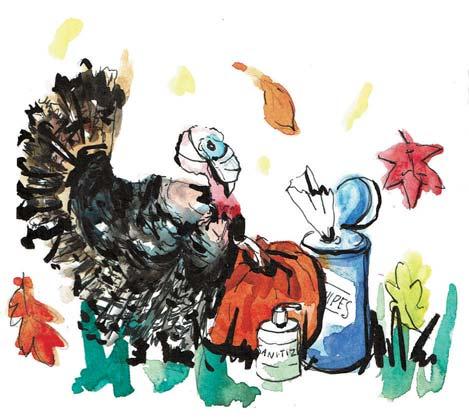
4. OUTFIT YOUR HOME AS A PRODUCTION STUDIO
After months of screen-first friendships, many of your guests have grown accustomed to instantly sharing their every thought, pouty look and dance move with the world. To keep them connected… • Install 150-watt bulbs throughout the master bath, where (everyone knows) the acoustics are best for your younger guests’ TikTok videos. • Establish a space free of childhood photos, spiderwebs, seasonal tchotchkes and anything else that would completely ruin your college students’ low-angle Snapchat stories. • Clear the countertops and turn on the oven light so Grandma can share her latest recipe posts on Facebook. While it can be challenging to navigate the New Normal, especially around the holidays, just remember that no matter how much the world changes, two things remain the same: family members drive each other crazy—and we love each other tremendously anyway. This Thanksgiving, may your beautifully-browned turkey be filled with carrots, garlic, shallots and cornbread stuffing. Just remember: in 2020, a bird is never fully dressed without a mask.






- Introducing the -
COLLECTION
This timeless collection is inspired by Bailey’s founder and ICON, “Mama” Ann Bailey. The collection is designed to take you through the $125, it’s perfect for the woman just starting her jewelry wardrobe, or for the woman looking to layer in freshness to an established jewelry box.
QE
Follow along with Marci Bailey on social @BaileysFineJewelry and share your iconic jewelry with #baileybox
Every Woman Wants a Bailey Box
Raleigh’s Cameron Village & Crabtree Valley Mall Rocky Mount | Greenville | www.baileybox.com
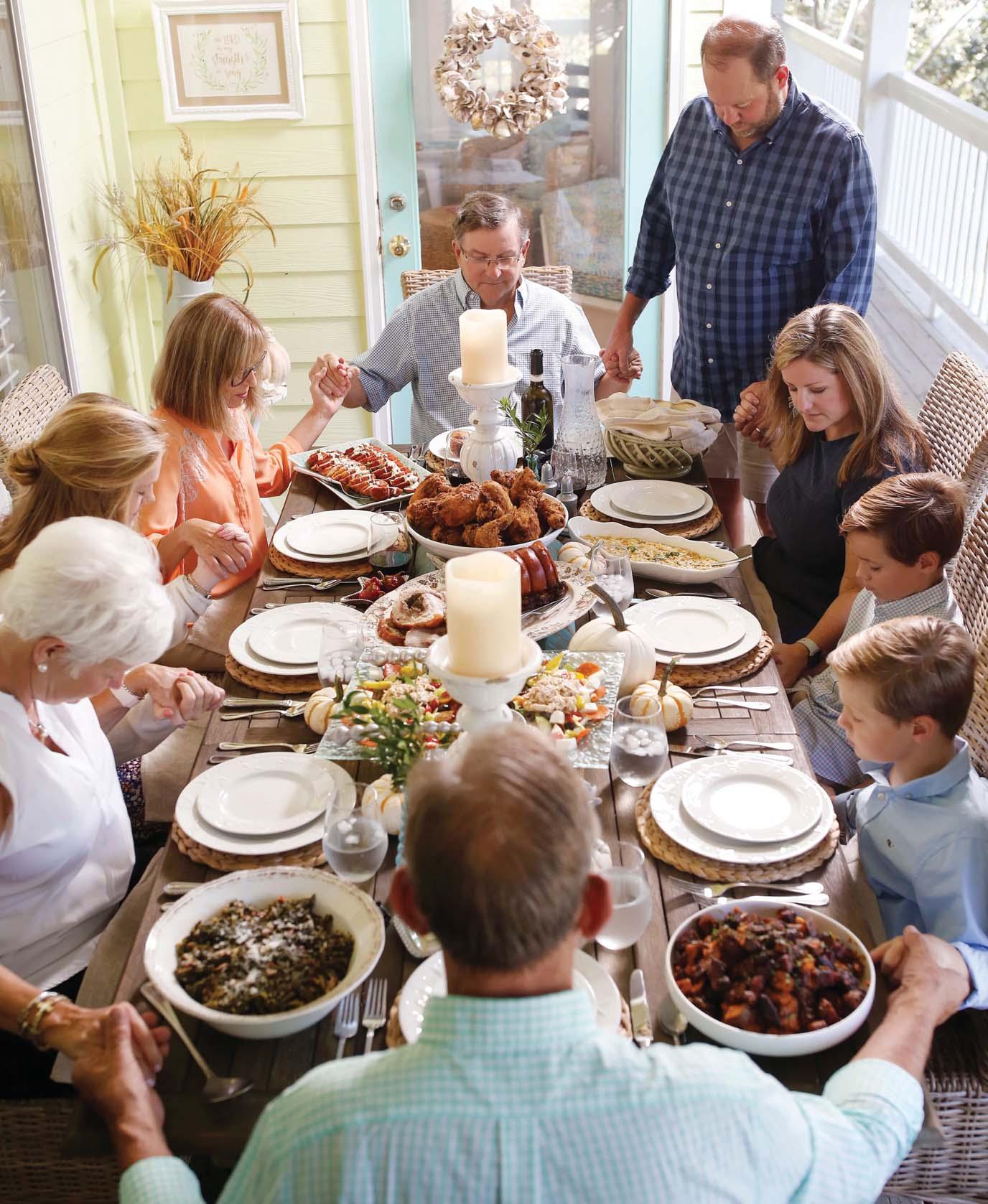
all in the FAMILY
Matt Register combines two types of Southern food, American and Italian, in his annual Thanksgiving menu
by CATHERINE CURRIN photography by EAMON QUEENEY
In most families, the Thanksgiving meal is about tradition: cooking from recipes passed down for generations, maybe adding a couple new twists. Turns out, the same is true even if you’re a chef. For this year’s Thanksgiving spread, WALTER trekked over to Kure Beach, where Matt Register, owner of mouthwatering, down-home joint Southern Smoke BBQ, typically hosts Thanksgiving. In his family, the meal isn’t just inspired by the whole hog, country cookin’ he’s known for—his wife Jessica comes from a long line of Southern Italians in upstate New York, so the Thanksgiving meal infuses two kinds of Southern: American and Italian. “True rustic Italian food is so much like true Southern food,” Register says. “It’s all about what’s seasonal. We’d make sweet potatoes because someone just brought my grandmother a bucket of sweet potatoes. We saved our corn from July to have for Thanksgiving and other holidays.” Similarly, some Italian staples like caprese salad and eggplant parmesan are favorites when tomatoes, basil and eggplants grow in the summer. The menu is always a smorgasbord of Italian favorites and Southern classics, and it’s all hands on deck, too—Register’s not the only one cooking. There’s a dry-rubbed porchetta with a crispy skin from Register’s father-in-law Jim Talerico (he learned the secrets in Tuscany) plus his father Tim Register’s famous fried chicken (you can get this one at the restaurant in Garland). There’s a colorful antipasto salad with mozzarella, olives and artichokes, which Register’s mother-in-law, Charmayne Talerico—a.k.a. Grandma Char—says is on the table at almost every meal. “I always think they’ll get sick of it, but they keep asking for it so I keep making it,” says Talerico. Register also puts his own twist on traditional recipes. He makes Utica collards—a Southern version of Utica greens, an upstate N.Y. staple of spicy,
Brown Butter Creamed Corn
Serves 4
INGREDIENTS
½ cup salted butter 8 ears fresh corn 1 ¼ cups heavy cream 3 cloves garlic, minced 2 tablespoons fresh basil, chopped 2 tablespoons sugar ½ tablespoon freshly ground black pepper

DIRECTIONS
In a 4-quart pot over medium heat, brown the butter; set aside. (It’s a good idea to refrigerate it to stop the cooking process, if you can). Cut the corn kernels from the cobs with a small paring knife and collect them in a large mixing bowl. Once the kernels have been removed, use the back of the knife blade and scrape along the cob to get the milky liquid out of the cob and into the mixing bowl. Set the bowl aside. You can discard all the cobs at this point except one. Cut the reserved cob in half to use like a soup bone. Transfer the cob halves to a small pot and add the heavy cream. Cook over medium heat until the cream begins to slowly boil, about 4 minutes. Immediately remove the pot from the heat and set aside. Place the pot with the brown butter back on the stove, over medium heat. If the butter solidified in the fridge, melt it again, then add the garlic, cut corn, basil, sugar and pepper and stir until well combined. Cook for 1 minute. Remove the corn cob halves from the heavy cream and slowly add the cream to the corn mixture. Stir until the mixture is uniform and reduce the heat to medium-low. Cook for 30 minutes, stirring periodically to prevent burning. The mixture will begin to thicken and become creamy as it cooks.
stewed greens—but swaps in collards for escarole and country ham for pancetta. He smokes turkey breasts instead of cooking a whole bird—“a breast is about $7 at the store, plus it’s easier. I love cooking it this way!”—using the same techniques that make his Garland outpost such a destination. At their core, most of his dishes are about making things easy, but also delicious. Take the hash: it’s a dish based on leftovers, says Register. “You can roast the sweet potatoes the day or two before and use them in this dish. I love things that come from something you’ve already got.” He says much of his cookbook, Southern Smoke, takes this approach. As far as dessert goes, Grandma Char is in charge—though there’s a longstanding debate in the Register household on which one of her pies is the favorite. The kids love her pumpkin and cream cheese pie, while Register swears by her apple walnut specialty. “I don’t even like apples, but I look forward to this pie!” More important than the food, Register says, is tradition. His mother Lynn Register says Sundays in Sampson County are sacred in their family, especially around the holidays. “We always celebrate the Sunday before Thanksgiving. Sunday lunch was our time with my mother, and we keep that tradition going,” she says. “If you weren’t going to be there for Sunday lunch, you better have had a good excuse.” Register reminisces on his grandmother’s lace cornbread (thinly fried, resembling a delicious doily) and her meticulous process of using the entire sink to dredge her signature fried chicken. He credits much of his love for cooking to time in the kitchen with his grandmother. “I believe the most important room in your house is your kitchen. On Thanksgiving, you put everything aside and you’re there as a family, in and out of the kitchen, cooking together.”
TK ford will open his French bistro, Jolie, in Spring of 2019
Pork Belly and Sweet Potato Hash
Serves 6
INGREDIENTS
4 medium sweet potatoes 2 pounds pork belly 2 tablespoons packed brown sugar 1 tablespoon ground cinnamon ¼ teaspoon ground ginger ¼ teaspoon ground nutmeg 2 tablespoons fresh parsley, chopped Pinch of sea salt
DIRECTIONS
Preheat the oven to 350 degrees. Dice the sweet potatoes into ½-inch pieces. Transfer the potatoes into a 3-quart casserole dish, cover with foil and roast for 30 minutes. Set potatoes aside and turn off the oven. (This can be done up to two days before.) Cut the pork belly into 1-inch pieces. In a 10-inch nonstick skillet, over medium heat, cook the pork belly for about 5 minutes or until it starts to brown. Add the brown sugar and sweet potatoes. Continue cooking for 4 minutes more or until potatoes become fork tender. Add cinnamon, ginger, nutmeg, parsley and sea salt. Stir to combine and cook for 2 minutes before serving.

Utica Collards
Serves 4
INGREDIENTS
3 pounds collard greens, chopped ¼ pound country ham ½ cup red and green bell peppers, chopped ¼ cup red onion, diced ¼ cup sliced cherry peppers 2 tablespoons minced garlic ½ cup parmesan cheese, grated ½ cup bread crumbs Salt and pepper
DIRECTIONS
Place country ham, peppers, onion and garlic in a bowl and toss with olive oil. Sauté mixture in a large pan until ham is crisp and vegetables are softened. Add chopped collards over the mixture and allow to wilt. Mix until all of the collards are broken down. Add salt, pepper, cheese and breadcrumbs.
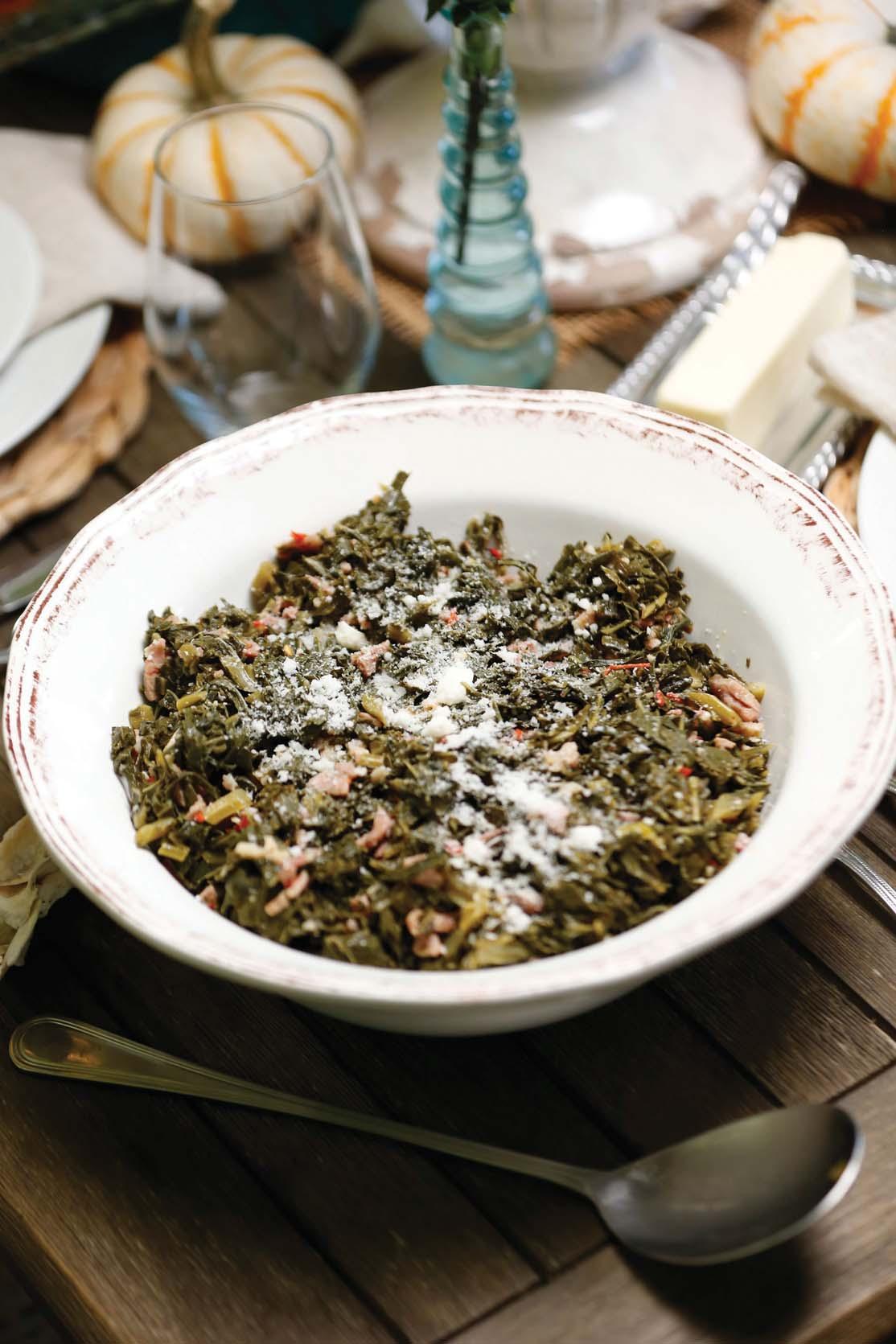
“True rustic Italian food is so much like true Southern food. It’s all about what’s seasonal.” —Matt Register
Chestnut soup with brown butter, topped with herbs and crispy parsnips.
Smoked Turkey
Serves 8-10

INGREDIENTS
½ cup cooking oil Turkey breasts (4 to 8 pounds) 1 tablespoon garlic powder 2 teaspoons seasoned salt 2 teaspoons paprika 1 teaspoon salt ¼ teaspoon freshly ground black pepper 1 cup packed brown sugar
DIRECTIONS
Prepare a smoker to run at 250 degrees. Pour the cooking oil over the turkey and use your hands to rub the oil all over its surface until it is completely coated. In a small bowl, mix together the garlic powder, seasoned salt, paprika, salt, pepper, basil and brown sugar until well combined. Pour the mixture over the oiled turkey Smoke the turkey until it reaches 160 degrees, about one hour per pound. Remove the turkey from the smoker and place it on a baking sheet. Lightly tent with foil and let rest for 30 minutes before slicing. Max waits patiently for someone to drop some food.

Buttermilk Fried Chicken
Serves 4
INGREDIENTS
1 whole chicken, cut into 8 pieces 1 ¼ teaspoon salt 1 teaspoon freshly ground black pepper 1 teaspoon paprika 1 quart buttermilk 3 cups flour Peanut or vegetable oil, for frying
DIRECTIONS
In a large bowl, season the chicken pieces with the salt, pepper, and paprika. Pour the buttermilk over the chicken and make sure each piece is submerged. Refrigerate for a minimum of 30 minutes or up to 8 hours. Remove the chicken from the refrigerator, then take the pieces out of the buttermilk and let them drain on a wire rack or butcher paper. Place the flour in a bowl. One by one, toss each piece of chicken in the flour, making sure it is evenly coated. For extra-crispy chicken, you can dip the coated chicken back into the buttermilk and then dip it back in flour a second time. In a Dutch oven, add oil until it is about 2 ½ inches deep. Heat the oil over medium heat to a temperature of 350 degrees (flour should sizzle when it is sprinkled in the oil). Fry each piece of chicken for 12 to 15 minutes, or until it reaches 167 degrees, flipping halfway through to get it golden brown on both sides. You can fry more than one piece at the time, but don’t crowd the Dutch oven so much at once that the temperature drops far below 350 degrees. When the chicken has finished cooking, remove it from the grease and set on a clean wire rack to cool.
Clockwise from left: Tim Register, Lynn Register, Taylor Grace Register, Charmayne Talerico, Jim Talerico, Harrison Register, Nash Register
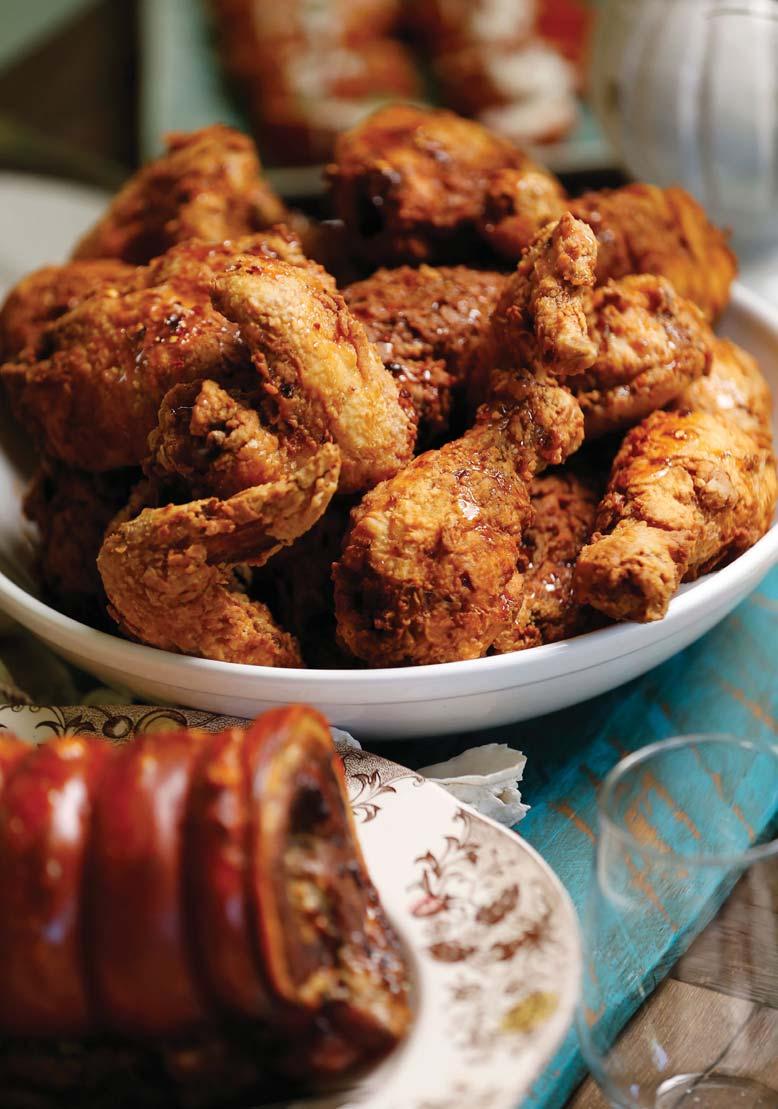
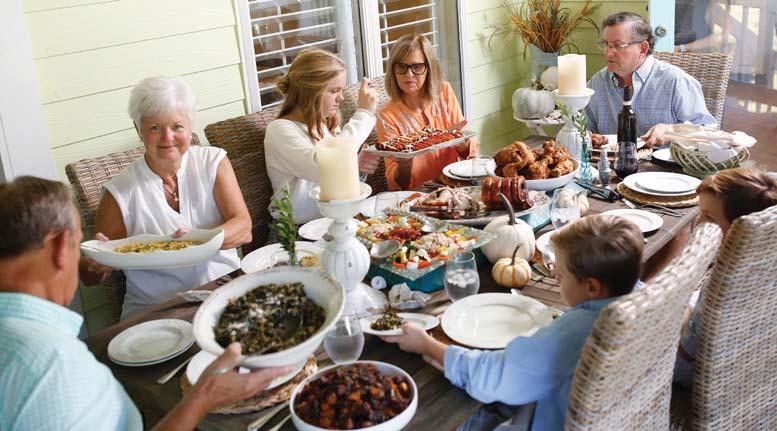
Grandma Char’s Crunchy Apple Pie
Serves 6-8
INGREDIENTS
Pre-made pie crust 7 Granny Smith Apples 1 tablespoon sugar 1 tablespoon cinnamon 1 cup melted butter ½ cup brown sugar ½ cup white sugar 1 cup flour 1 egg beaten 1 ½ cup chopped walnuts Pinch of salt
DIRECTIONS
Preheat an oven to 350 degrees. Mix apple slices with both sugars and cinnamon. Pour apple mixture into pie crust. Blend melted butter, flour, eggs, sugar, chopped walnuts and salt. Pour the mixture over the apples. Bake for 45 minutes.
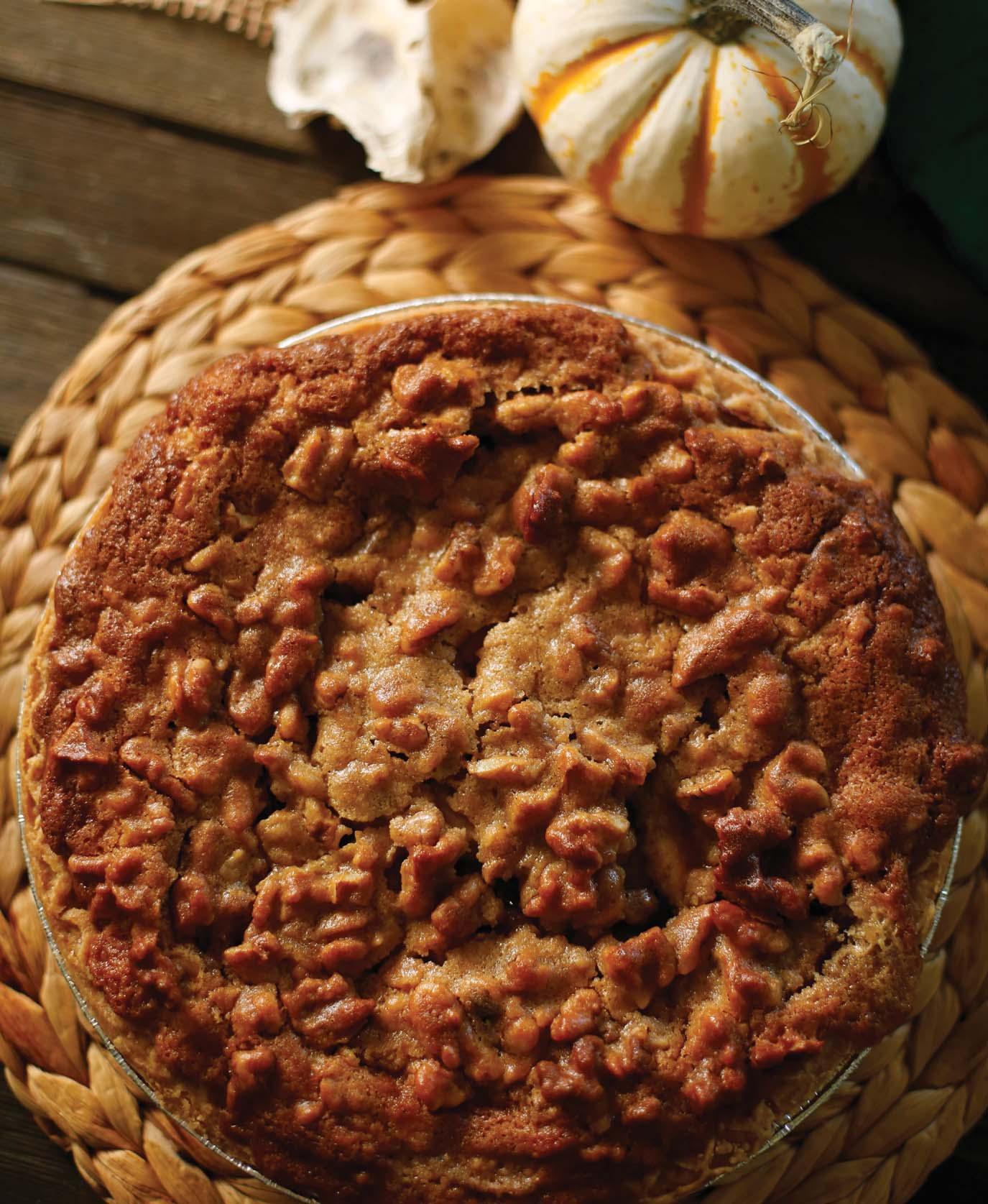
How a self-educated runaway became an advocate for mental health
The Intrepid Life of DOROTHEA DIX
by JOEL HAAS



Joshua Steadman (DIX PARK); Barden Collection/North Carolina State Archives, Raleigh, NC. (DOROTHEA DIX); Getty Images (FRAME) Dorothea Lynde Dix was more than a hospital or a park. In fact, Dix Hospital was not actually named for her, and she may have been outraged—or at least, ambivalent—at the grounds’ new use as a park. An examination of her biographies, along with dozens of “memorials”—letters, speeches and notes she penned herself—reveal a woman with an unusual path and sometimes contradictory views. Born in Hampden, Maine in 1802 to an abusive religious fanatic father and a clinically depressed mother indifferent to her daughter, “Dolly” ran away at age 12 to live with her wealthy grandmother in Worcester, Massachusetts. The widow of a prominent Worcester physician and land speculator, Dr. Elijah Dix, this stern, pious taskmaster drilled into her granddaughter that gray areas did not exist. Self-educated and a voracious reader, Dolly Dix turned to teaching to earn money to bring her two much younger brothers to Worcester. At age 14, she opened a grammar school for girls of wealthy families. Five feet tall and slender, she knew she barely looked a teenager, let alone qualified to teach. So she lengthened her skirts, wore long sleeved blouses and rolled her abundant hair into tight buns to look older. It worked. Her school was a success. Dix was deeply religious, and felt bound to open a free evening school for poor girls. Her perfectionism drove her to rise early, then stay up late grading papers and writing lesson plans. By age 19 she was using one school to support the other, while running her aging grandmother’s estate. In 1831, she collapsed with exhaustion and coughed blood from tuberculosis. To recover, she took a less onerous job, tutoring the children of a prominent Rhode Island Unitarian preacher, Reverend William Channing. Channing’s family adored her and took her twice with them in summertime to St. Croix, then a Danish colony. While in St. Croix, she expanded her passion for studying nature. She sought out plants, animals, birds—whatever would stand still—to study and illustrate with meticulous watercolors. She continued to collect rocks, plants and any other natural phenomena in her future travels. In the Caribbean she saw slavery for the first time. Her strict sense of morality gave her a strange outlook: she wrote that she “envied” the slaves’ “carefree attitudes” toward life. (It seems that by her own uptight New England upbringing, it seemed impossible to be both pious and cheerful.) It would be immoral, she declared, for her to teach slaves these principles and thereby make them unhappy. The sinners were the owners, she said, who shirked their Christian duty to teach slaves morality. As her health recovered, Dix returned to teaching and took up writing. She produced the first handbook of American flowers in 1827, as well as several children’s books. Her book Conversations on Common Things went into 60 printings in her lifetime. Her health collapsed again in 1836. Physicians recommended she go to Europe. When she arrived in Liverpool, England, friends of Channing, the Rathbones, took her in as part of their family. It was the happiest 18 months of her life, she wrote. She roamed the area recording everything from geology to insects, and even wrote of using the Earl of Rosse’s telescope—then the largest in the world—to study astronomy. Returning to Massachusetts, Dix learned that her grandmother had died, leaving behind a considerable fortune. Book royalties and this inheritance would enable Dix to live comfortably the rest of her life. Her health had still not completely recovered, so she set about attending to the estate, while reading and writing poetry. By this time, she was 36, a wealthy spinster, but her intelligence and blunt, imperious manner seemingly dissuaded suitors, according to her biographers. Chance led her to take up social justice in a field that few people at the time even thought of. She was asked to teach Sunday school at the East Cambridge Women’s Prison. It was only to be a few
hours a week, so she accepted. She left her first Sunday visit horrified. She discovered women with mental illness, charged with no crimes, were nearly naked and fed scraps, chained in cells alongside the criminal population, standing and sleeping in their own waste. Confronted, the warden replied he conformed to all common practices and laws. After all, the women were consigned there by the county as, in the parlance of the time, “looney paupers." Dix set out to see for herself if the warden was lying. For two years, she visited every jail and poorhouse in the state. The warden wasn’t lying; in some places, conditions were even worse. accusations, the Massachusetts legislature launched its own investigation. Finding her report accurate, in 1843, they approved construction of a state hospital. By then, Dix had set out to see conditions elsewhere. Traveling by boat, rail, wagon, horse and on foot, she visited jails and poorhouses from New Hampshire to Louisiana. When Texas joined the Union, she traveled there. She went to California soon after it became a state. She successfully submitted memorials to legislators asking for funding to build hospitals to treat patients in New Jersey, Illinois, and Pennsylvania. In 1848, she came to North Carolina. Here, she traveled to 40 counties visiting
Between travels, she read widely on the “insane and idiots” (those we now refer to as people who have mental illness and those who are born with intellectual or developmental disabilities) and met some of the leading experts of the day. The public’s prevailing view at the time was these people were unaware of their surroundings—they were people without memories or feelings. Dix disagreed. She concluded that the people she encountered were very aware of their surroundings and poor treatment and they had memories and feelings like anybody else. “Nobody was ever beaten back into sanity,” she noted. Whether or not they could be “cured,” Dix believed society had a duty to treat people who have mental illness or who are born with intellectual or developmental disabilities with dignity, kindness and employment. Dix persuaded a prominent, sympathetic doctor, Dr. S.G. Howe, to write a newspaper article about her findings. The reaction was outrage. Surely, conditions could not be so bad. To disprove her jails and poorhouses. She persuaded a state senator to present her memorial of findings to the legislature. The reaction was polite, but condescending. The N.C. legislature supported “lower taxes to attract business” over public welfare spending. A Yankee spinster’s advice was not needed. The bill was rejected. By chance, Dix stayed in the same Raleigh hotel as a legislator named James C. Dobbins and his wife, Louisa, who became deathly ill during her visit. Dix was her constant attendant and nurse, staying with her even after the hospital bill was defeated. On her deathbed, Louisa Dobbins made her husband promise to work to see Dix’s bill passed. Soon after the funeral, Dobbins and Dix walked into the Capitol building’s House chamber together. Dobbins reintroduced Dix’s bill and, keeping his promise, worked to see it passed. By 1856, Dix Hospital had been completed in Raleigh. Out of modesty, she asked it be named for her physician grandfather, Dr. Elijah Dix. (The name was changed to Dorothea Dix in 2005.) Leaving Raleigh, she moved on to successfully persuade Alabama and Mississippi to establish state hospitals. Dix did not stop at the borders of the United States. In the summers of the 1850s, she visited Nova Scotia, Newfoundland and St. John’s Island. By chance, she participated in the rescue of a sinking ship in Nova Scotia. Afterward, she campaigned for more life-saving equipment. Eventually, $60,000 was appropriated by Nova Scotia and Dix added money of her own—and her friends in Nova Scotia reported the new items were instrumental in saving an American ship the day after they arrived. Dix went to Washington, D.C. in early 1849. The Mexican-American War had gained the United States vast territories, most of which were declared federal lands. General Zachary Taylor, hero of the Mexican-American War, had just been elected president. Dix intended to persuade the new administration to grant five million acres of federal land for “The Benefit of the Indigent Insane.” In the whirl of parties and pre-inauguration festivities, she made the acquaintance of the incoming vice president, Millard Fillmore. The two were to carry on a sometimes passionate correspondence until Fillmore’s death in 1874. Taylor died in July 1850. Dix’s new friend was now president. Passage of her bill seemed assured. She stayed in Washington quietly building support, but the bill failed. Undaunted, she returned to Washington when the new Congress convened. This time she asked for 12 million acres of federal land. Support increased, but Congress adjourned without taking up the bill. Fillmore’s term would be over when Congress convened again. Ominously, one of the bill’s strongest opponents, Senator Franklin Pierce of New Hampshire, was elected President. Persistent, Dix came back to Congress a third time, increasing her request to 12 million acres and $100,000 for “The Benefit of the Indigent Insane.” This time, the bill passed easily. But success was short lived. While proclaiming sympathy for her cause,


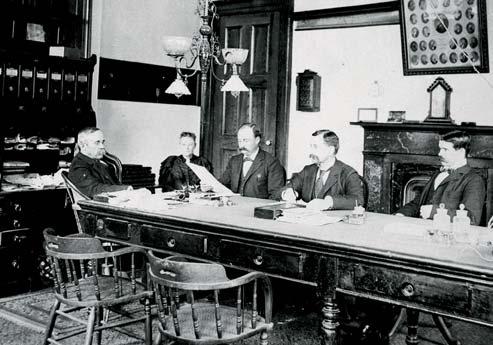



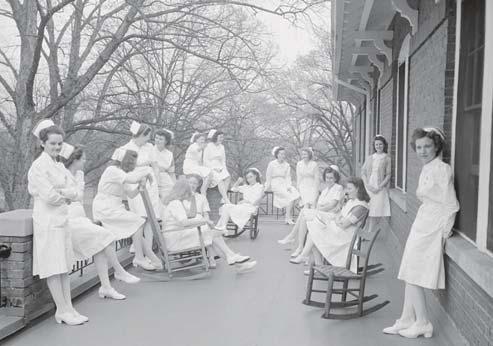
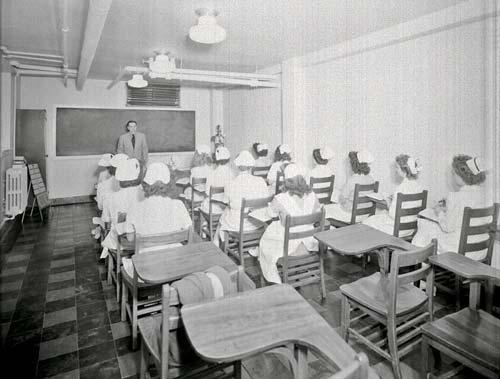
From top left: Dix Hill Administration Building 1940; A class of nurses in 1946; Aerial view of the State Penitentiary/Central Prison and Dix Hospital campus 1919; Nurses classes 1946; Historic building on Dix Hill; Hospital staff in 1896.
From top left: Nurse classes; Nurses Housing at the State Hospital; newspaper clipping from Nova Scotia; Dix tables.

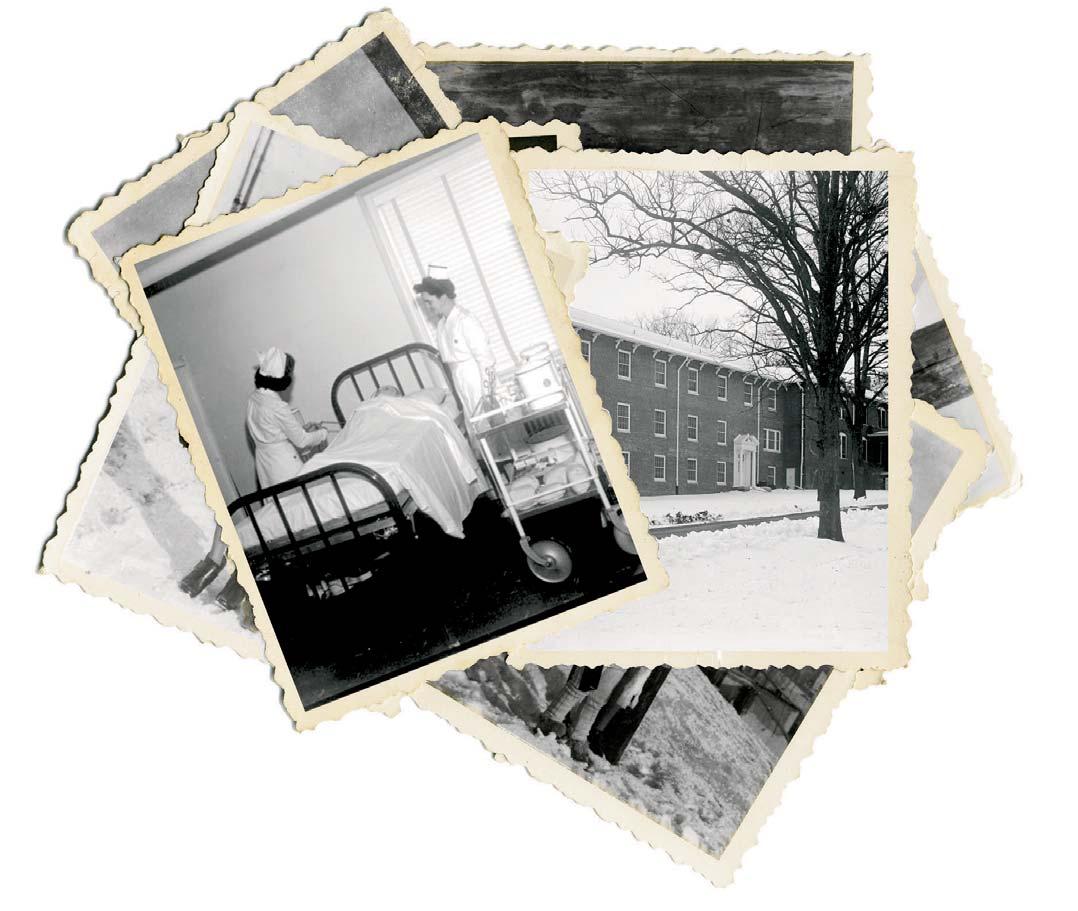









President Pierce vetoed the bill. In a 6,450-word message to Congress, Pierce argued social welfare was the states’ responsibility, not the federal government’s. Furthermore, Pierce argued, allowing this bill would simply encourage other social groups to petition for federal money and land. Heartbroken, Dix left America for England. She planned to stay with her friends the Rathbones again, to relax and recover. She was no longer a young woman looking for an accepting family now. She was in her early 50s with a record of successes behind her. She couldn’t stay still. Hearing of deplorable conditions in hospitals in Scotland, she set out to investigate. As in America, she visited every place she could, recording what she saw. Returning to Liverpool, she sent memorials of her findings to influential members of parliament. The result was construction of two new Scottish hospitals to be operated according to her recommendations. By 1858, she was back in the U.S., crusading for the poor and those with mental illness and intellectual or developmental disabilities. By now, she was one of the most-widely known and admired women in America. She had so many friends across the country, she seldom had to book a hotel. Where she could not change a system, she raised money to send books and clothes to prisons and poorhouses. She lived on very little. A story is told that she was riding in a buggy in rural Michigan when it was held up. She confronted the robber, offering her purse if he would leave others alone. The robber recognized her, declaring she had been kind to him years before when he was in jail. He declined to take her money. Forcing it on him, she made him promise he would forego robbing some other “honest man or woman,” in exchange. According to her biographies, in early 1861, while visiting Maryland, Dix overheard men planning to cut railroad and telegraph lines, march on Washington with a private militia and declare themselves de facto rulers of the United States before Lincoln’s inauguration. Lincoln himself was to be kidnapped and killed. Dix was friends with Samuel Felton, president of the Philadelphia and Baltimore Railroad, responsible for bringing Lincoln to Washington. Hastily, she went to Felton, telling him what she had heard. With that warning, Felton alerted Allen Pinkerton and Lincoln was saved and reached Washington. “Why then,” Felton asked, “don’t you
reveal this? All the world knows this story and believes it was Mr. Pinkerton who learned of the plot and foiled it!” Dix replied it would be immodest of a woman to claim such a thing. Dix’s reputation was so great that at the outbreak of the Civil War, she was appointed Superintendent of U.S. Army Women Nurses. For the next four years, she trained nurses to her high standards and forced Army doctors to allow her nurses into their hospitals. She refused pay and gave herself no furloughs. Worried her nurses would be sexually harassed by Army doctors, she wished to recruit only “women between the ages of 35 and 50 and of plain appearance.” Her nurses were to dress “without jewelry and wear plain dresses of black, gray or brown with no hoops.” She was strict. One of her nurses, Louisa May Alcott, called her ‘Dragon Dix’ in a letter home. (Many Army doctors called her much worse.) In mid-1863, some of her authority was taken away from her. She resigned her post in June 1865 and immediately returned to raising money for hospitals. By 1881, her respiratory problems returned, and she was exhausted. No longer able to travel, she retired to the suite of rooms built years before in a New Jersey Asylum for her use. From there, she continued advocating for the disadvantaged through her letter writing, which hardly slowed down. In 1887, age 85, Dorothea Lynde Dix passed away. In her lifetime, Dix held as many backward and puzzling views as she did forward-thinking ones. For example, while advocating decent treatment of those in need, she believed mental illness only affected white people. The brains of Black poeple, she wrote, were not sufficiently developed to become disor-
dered. Why she would believe this in the face of her own evidence is a mystery. Privately, she was a woman full of passions, raised in an era and household which suppressed them. As hinted at in her reaction to the “carefree” slaves, she believed morality was essential, but that it made people unhappy. She wrote and read poetry “to live,” she once said. Once, asked if she felt she was an example to young women, she vigorously denied it, hoping instead they “would not be so unfortunate as she” and instead, be happy becoming dutiful daughters, good wives, mothers and housekeepers. Starting in the late 1960s, Dix’s legacy began crumbling. Buildings erected in the 1800s were oudated and hard to keep up. Dix desired to separate people with mental illness and developmental and intellectual disabilities from what she perceived as an unfriendly public, but practice turned toward integrating them into communities. Many of the 32 hospitals Dix founded or helped establish were closed, including Raleigh's hospital. But what remains of Dix’ legacy is twofold: to treat people with mental illness and developmental and intellectual disabilities with kindness and support, and to stop identifying their actions as criminal behavior. Dix’s empathy, meticulous reporting and dogged advocacy started a tidal, societal shift.
At the outbreak of the Civil War, Dix was appointed Superintendent of U.S. Army Women Nurses… One of her nurses, Louisa May Alcott, called her ‘Dragon Dix’ in a letter home.
slant ofLIGHT

As fall turned to winter, photographer Juli Leonard visited the JC Raulston Arboretum. North Carolina Poet Laureate Jaki Shelton Green created poetic vignettes inspired by the images she captured.
by JAKI SHELTON GREEN photographs by JULI LEONARD
The children are always listening. Sometimes they hide in the bramble weeds pretending to be mosquitoes. Sometimes they are dandelion puffs just floating by leaving no marks.
Tangled. Wild Violet. Pig Weed. Thistle. Poison Ivy. Nightshade. Nettle. They all live here beneath the stone wall of regret that is a wild tangled tango.

Open the hidden hand. Find your new path folded neatly inside the palm. The old path is there waiting to become a memory.



Me: We must always ask permission of the plants. Daughter: Please show me your beautiful bones and I’ll show you mine.
It was the fluttering of wings inside the weight of her skirt that sang her awake. She remembered another time when she could fly.
Come closer. Lean into the windows of my gilded crown. I will tell you a story about a world as golden as you.
A single slant of light is always an invitation to bloom wherever we are.



Dawn whispers itself into the day. Sleepy feet rise and run to chase maple leaves chasing rain.
The prancing light at dusk reminded the aging woman of other gardens, other calendars of waiting. She lifted each petal as tenderly as the lifting of chenille, silk, and organza, reminding herself that there are still dances to be danced.

Sun bends the edges of another season. Each blade of grass remembers its name. Spiders keep spinning into the feast of winter night.of winter night.

We. all the veils waiting to be lifted. We. all the veils waiting to be kissed by the wind.


Matt Robinson/RaleighSkyline.com LIVE GIVE where you
25 big-impact local organizations that deserve our support this year
by SUSANNA KLINGENBERG
Gathering, feasting, reflecting with loved ones: the rituals of November will look a bit different this year. But at the heart of the month is gratitude, a feeling that not even a pandemic can shake.
This month, we’re highlighting 25 Triangle nonprofits that have met this challenging year with creativity, grit and a renewed focus on improving the lives of those they serve. Your financial contributions are critical to the continued work of these organizations, and they will turn your dollars into aid for our neighbors who need it most.
This list is by no means comprehensive—our community is full of organizations working toward a better world, and we wish we could highlight them all! But we hope that, as you feel the spirit of gratitude move you this season, you will give generously to those who support the region we call home.
Alliance Medical Ministry
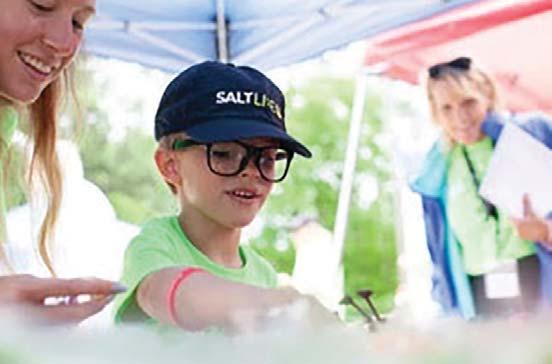

Alliance Medical Ministry provides affordable healthcare— medical care, counseling, and overall wellness programs—for working, uninsured adults in Raleigh. They were one of the first nonprofit clinics in N.C. to pivot to telehealth in March. alliancemedicalministry.org 1
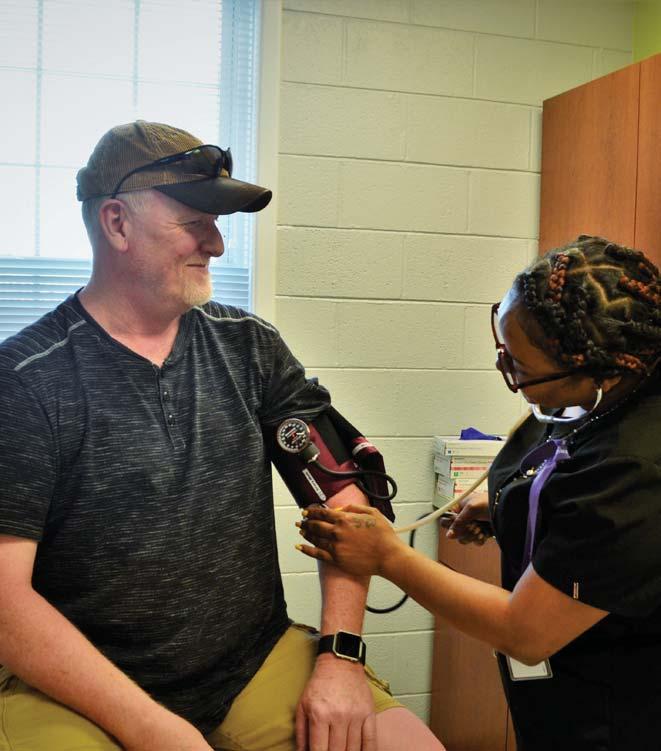
Beyond Fences
Beyond Fences provides free veterinary services, supplies and support to people in underserved communities, assisting families and their pets with a philosophy of trust and non-judgement. When money is tight, animals often feel the strain; Beyond Fences takes care of the basics, so furry friends can continue bringing joy. beyondfences.org 2
3
Bryce Martin Foundation
Founded by Dr. Megan Martin in honor of her son, the Bryce Martin Foundation supports children who are blind or have visual impairments in North Carolina through early intervention, ongoing education, critical technology and extracurricular activities. brycemartinfoundation.org
4
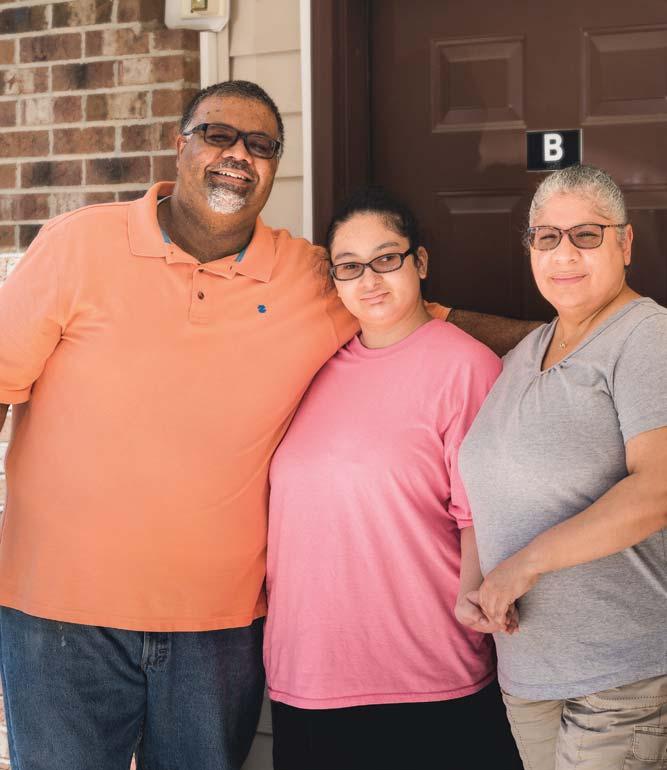
CASA
CASA builds and manages rental housing for those at risk of homelessness, including many of the populations most affected by the COVID-19 pandemic. Last year, they helped move 633 people—including families, veterans and people with disabilities—into stable, affordable homes. casanc.org
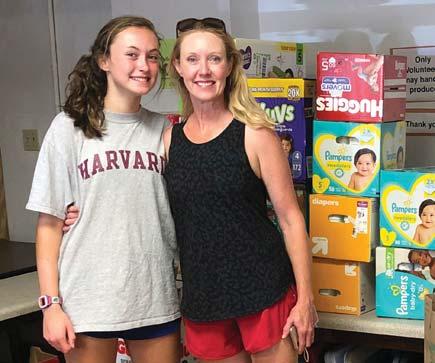
The Daniel Center for Math & Science

5The Diaper Train New moms have enough to worry about, but one in three parents in our area has had to choose between buying diapers or food. Diaper Train bridges that gap by providing diapers, wipes and books to low-income families in Wake County. saintsaviourcenter.org/impact/diaper-train 6
The Daniel Center is a STEM-focused childcare center aiming to narrow the education gap for at-risk and disadvantaged children, ages three through college. To support remote learning, they have shifted from offering after-school care to overseeing small-group virtual learning during the school day as part of the Families and Schools Together (FAST) program. danielcenter.org

8 7

El Pueblo
El Pueblo supports Wake County’s growing Latinx community by encouraging civic participation and advocacy, nurturing leadership in children and adults and celebrating Latin American culture. elpueblo.org
Families and Schools Together
A collaboration between recreation and education centers, Families and Schools Together (FAST) works to ensure every family in Wake County has access to safe, affordable support for remote learning. “We’re serving more than 3,000 students every week,” says Keith Poston, president of WakeEd Partnership. The program also offer kids social interaction, enrichment and screen-free time to move. wakeed.org/fast
Emancipate NC
Emancipate NC works to dismantle structural racism and racialized mass incarceration in North Carolina. A recent project of the Carolina Justice Policy Center, which has sought criminal justice system reform since the 1970s, Emancipate NC lobbies, organizes mobilization, offers training for churches and other organizations and supports directly-impacted people and their families. emancipatenc.org

9
Friends of the Museum
Friends of the Museum of Natural Sciences supports the Museum’s educational programs, exhibits and research to illuminate the natural world and inspire conservation. Their work allowed continued access to the Museum’s resources during stay-at-home orders. If you’ve ever stood in awe of Acro or wandered the trails at Prairie Ridge, consider supporting this cultural pillar. naturalsciences.org/support/donate

10
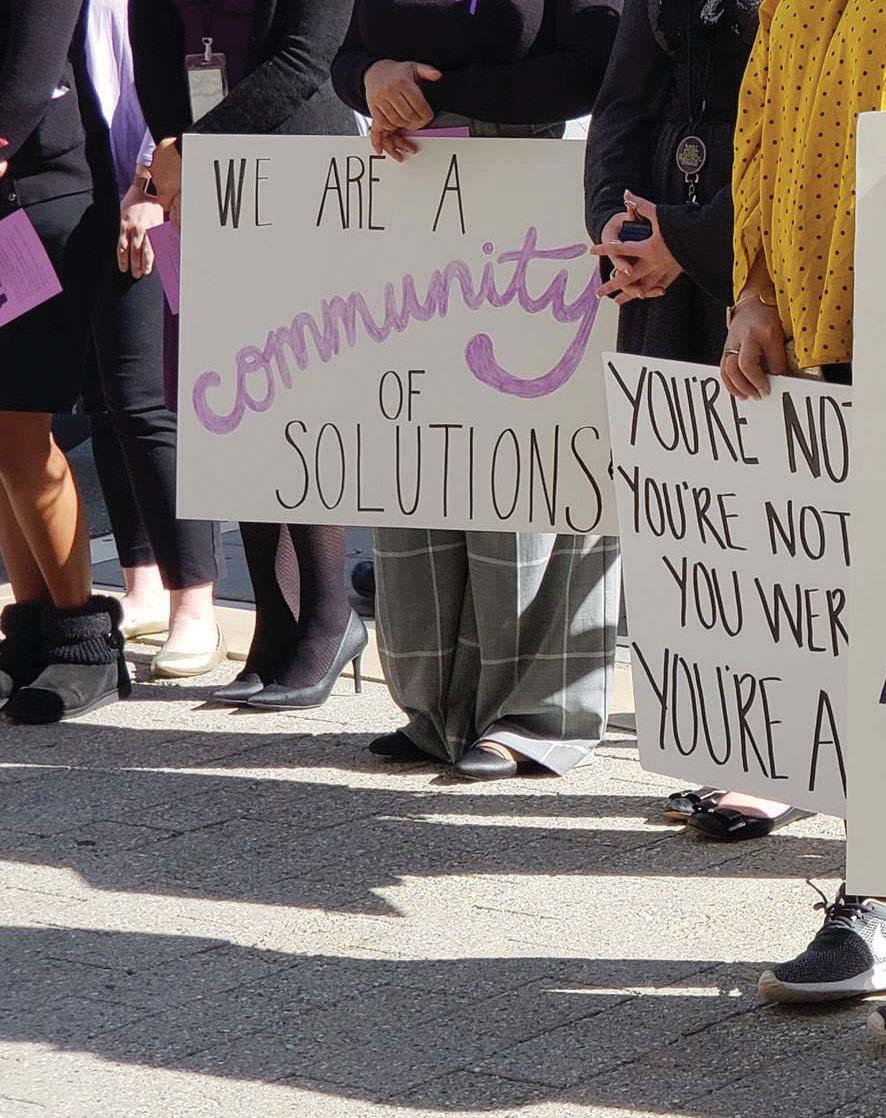
11
The Hope Center at Pullen

The Hope Center at Pullen serves youth aging out of foster care and transitioning into adulthood. They offer safe, stable housing and build life skills, coaching youth toward employment and educational goals. hopecenteratpullen.org
12
InterAct
InterAct helps to save and rebuild the lives of victims of domestic and sexual violence in Wake County. The stress of the pandemic has led to increased domestic violence, and InterAct has stepped up in response, offering a socially-distanced shelter for 30 families and moving their support services, such as crisis counseling and court advocacy, online. interactofwake.org
Interfaith Prison Ministry for Women


Women are the fastest growing segment of the prison population, but once they have served their time, many struggle to find jobs, housing and social services. Interfaith Prison Ministry for Women (IPMW) equips these women to heal and thrive both in prison and in their eventual communities. Their comprehensive approach includes trauma-informed chaplaincy programs, practical life and job skills and reentry support. ipmforwomen.org 13
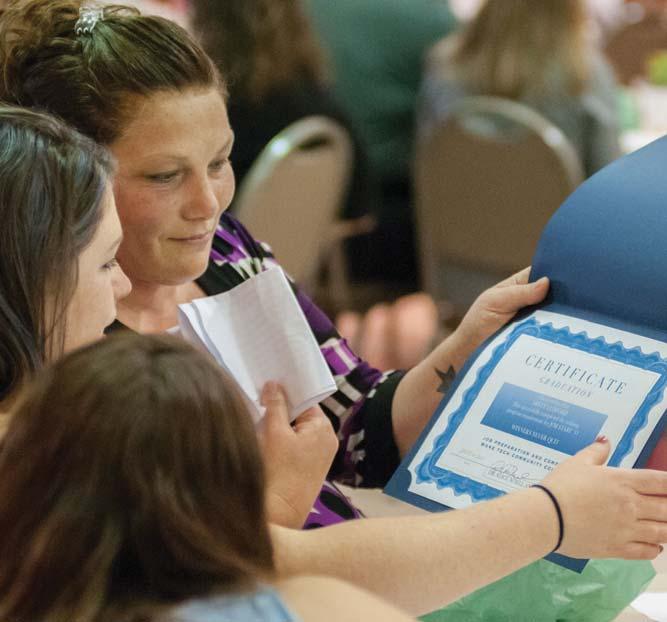
LGBT Center
The LGBT Center serves, empowers and advocates for the well-being of the diverse LGBTQIA+ communities in and around Raleigh. Though the pandemic has moved their packed calendar online, the center remains a hub for education, connection, health, growth and fun. lgbtcenterofraleigh.com
14 15
The Lucy Daniels Center
The Lucy Daniels Center in Cary provides Triangle families a range of mental health services: counseling, an on-site school, evaluations, parenting classes and most recently, free, shortterm help navigating parenting issues related to COVID-19. lucydanielscenter.org
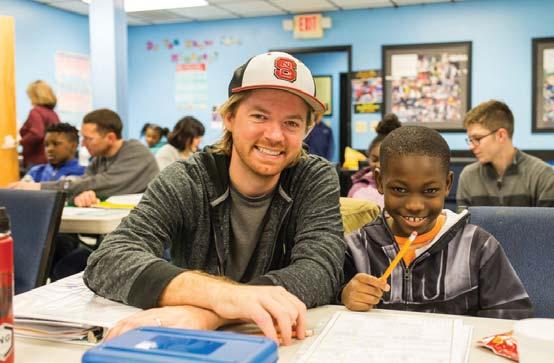
17 16
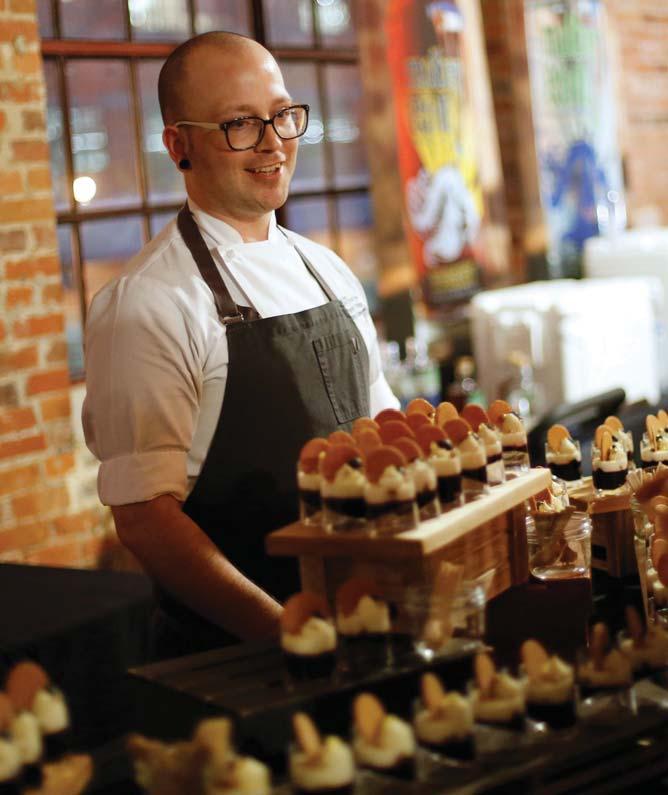
NC Restaurant Workers Relief Fund
Founded by Raleigh chefs at the onset of the pandemic, the NC Restaurant Workers Relief Fund supports the thousands of North Carolinians from the restaurant and hospitality industry who lost jobs due to COVID-19. Missing your favorite server, barista or bartender? This is a way to lend your support until they’re back on the job. ncrestaurantrelief.com
Partners for Environmental Justice
Starting with stream cleanups along Walnut Creek in the 1990s, Partners for Environmental Justice (PEJ) advocates for the equitable treatment of human and natural communities in Southeast Raleigh. “As PEJ continues to grow, I want us to become known as a leading environmental and social justice organization, while remaining deeply rooted in community,” says program director Tatiana Height. pejraleighnc.org
Neighbor to Neighbor

Neighbor to Neighbor combats the effects of poverty through mentoring relationships for young people. They tackle it through short-term tutoring, long-term goal-setting and extracurriculars, from chess to auto-mechanics. Donate or hire them directly: their catering and moving enterprises offer a living wage for N2N graduates. n2noutreach.org 18

19
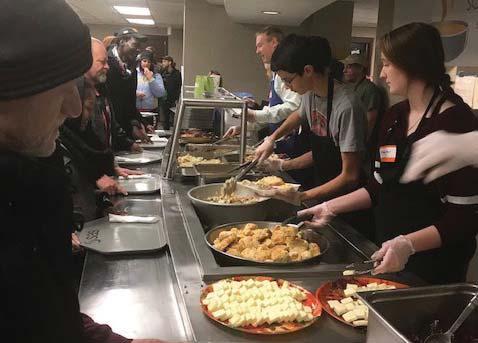
Shepherd’s Table
The soup kitchen at Shepherd’s Table serves around 250 hot meals a day to anyone who comes to their door. It’s known by diners and volunteers alike for its gracious hospitality. “That spirit isn’t just in the food, but in our volunteers,” says executive director Tammy Gregory. shepherds-table.org
21

TheGifted Arts

TheGifted Arts helps close the opportunity gap by teaching young people a variety of arts—dance, drama, music—in a competitive but nurturing atmosphere. Its programs build character, confidence and leadership, and need-based scholarships make it accessible to every child. thegiftedarts.org
20
ShopSpace
ShopSpace is a nonprofit metalworking studio, but it’s more than just a place to build with forges and hammers—it’s a place to build community. Its mission is to encourage people of all skill levels to put down their screens and work with their hands, these days through masked classes and a wide-open space off Capital Boulevard. “People are looking for an outlet to relieve stress and be creative,” says co-founder Lucas House. shopspace.org
22
United Arts Council
Since 1962, the United Arts Council of Raleigh & Wake County has been supporting local artists, teachers and arts organizations. “Not only are they essential to economic development and recovery, but art and culture bring people together and help us build a more equitable and inclusive community,” says president Charles Phaneuf. unitedarts.org
United Way of the Greater Triangle
In pursuit of its mission to eradicate poverty and increase social mobility, United Way of the Greater Triangle (UWGT) funds 85 local nonprofits through an equity-driven lens. Their partner organizations focus on early childhood education, workforce development, mental health support, food insecurity and affordable housing. unitedwaytriangle.org
23 25
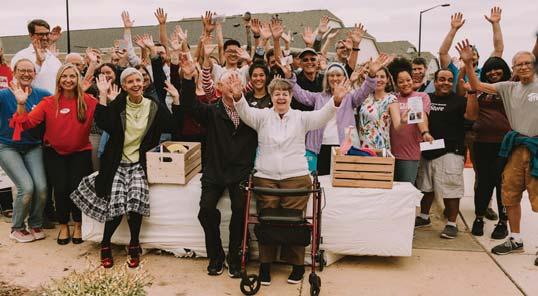
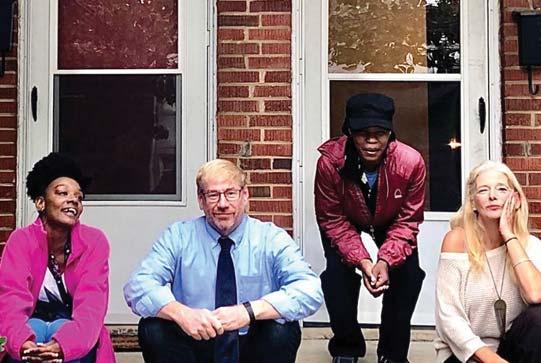
Women’s Center
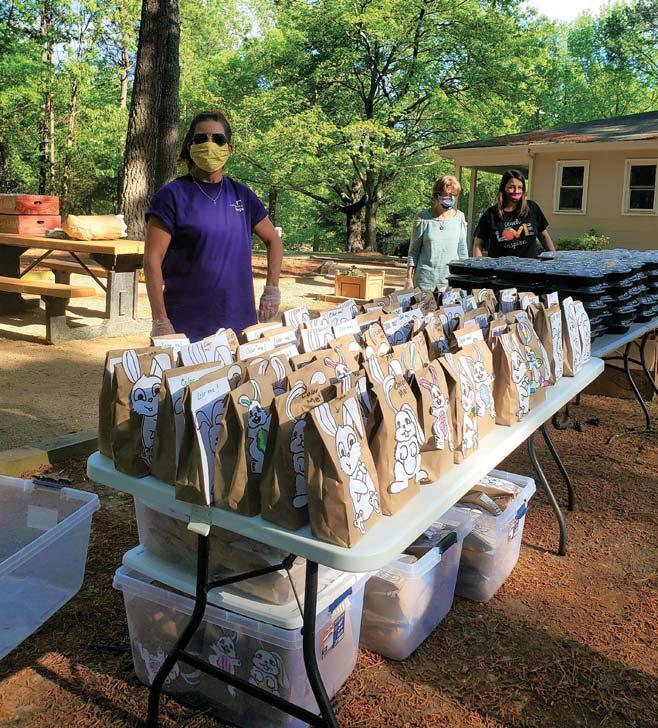
The Women’s Center works with the Triangle’s most vulnerable, at-risk women to break cycles of trauma, abuse and homelessness. In August, its services, including healthcare, housing, meals and counseling, moved to a welcoming new campus on S. West Street in downtown Raleigh. wcwc.org
Western Regional Food Security Action Group
The Food Security Action Group partners with volunteers, faith groups and businesses to coordinate emergency grocery distribution in neighborhoods at risk of food insecurity. In response to COVID-19, they have also partnered with Wake County Public Schools to offer to-go breakfast and lunch—a critical resource for families when school meals are not available. westernregionfoodsecurity.com 24
From left: Furnishings in the showroom of The Green Chair Project; Volunteer Melanie Crockett carrit in front of the couch she chose at The Green Chair Project.
MOMENT OF ZEN
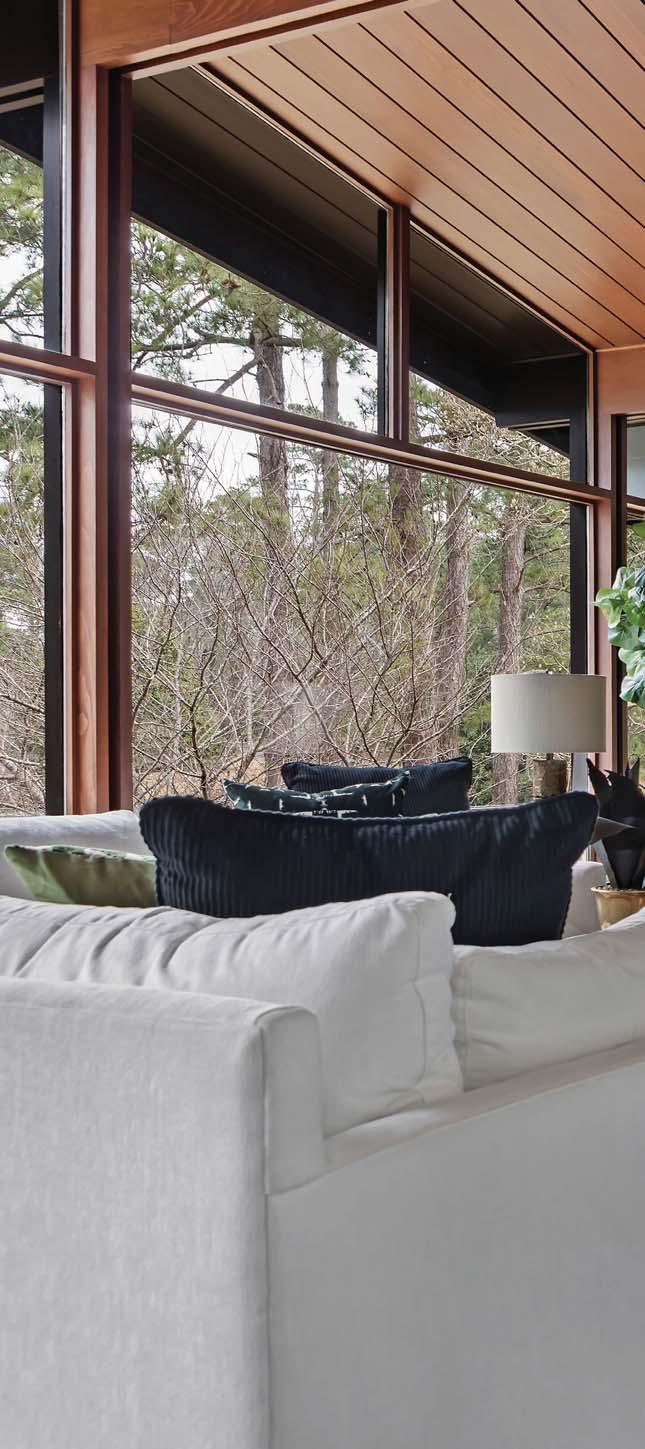
East meets West in an updated Mid-century retreat
by ANDREA RICE photographs by CATHERINE NGUYEN
Inside this Clinton living room are striking wood-paneled ceilings and a wall of windows. The Williams family built in an entertainment center with gold knobs from Addison Weeks to create a focal point.


AMid-century modern beauty is tucked away in an otherwise unassuming Clinton neighborhood. It’s nestled atop a ridge and overlooks a tranquil pond, and it’s here that Robbie and Todd Williams have created a sanctuary that bridges the past and the future. The Williamses purchased the 1962 home from its original owners two years ago. They’d been living in more traditional homes in Wake Forest as they raised their family, but once their children, Mabry and Ford, had grown and moved out, the couple wanted to return to their hometown to reconnect with their roots and be closer to their parents as well as to the beach. After looking at a few listings in the area, a home adjacent to Coharie Country Club caught their attention. “Even though we grew up here, we had never been inside this house,” Robbie Williams says. “From the outside it looked like a traditional ranch home, but as soon as we walked in the front door and saw the wall of windows and the fireplace, we knew this was the one.”

The two-sided, copper-topped fireplace in the living room is original to the home—it was in mint condition, and only needed to be dusted off. “I loved incorporating the unique fireplace into the plan. It set the vibe for the entire design,” says Summerford. The coffee table (above left) was a lucky Craigslist find, and the couch and chairs are from Homebridge Design in Raleigh. The small bar (below left) was found at George R. McNeill Fine Antiques in Raleigh. Art pieces from travels to Paris, London, Hong Kong, Bangkok, Jakarta and Ocho Rios adorn the space.

Summerford had been saving a set of Italian leather chairs from the 1950s for the “perfect client.” The dining room table had always been in the family. For additional seating, a set of chairs were lacquered at Steins Furniture and Lacquer Studio and reupholstered by Designers Guild. Except for a dishwasher, the kitchen (right) was original to the home— which, Williams says, was ideal, since it meant “no one had done a bad ‘80s remodel.” They gutted and reconfigured the space to connect it to the living area. The black cabinets and stained island complement the original wood.



It had always been on Robbie Williams’ wish list to redesign a Mid-century home, to usher it into the present while respecting its character and integrity. “Mid-century homes can have a lot of hard edges, and I wanted it to be comfortable and soft,” she says. That said, “Deciding what to keep and what to change was just outside of my comfort zone,” she says, so she looked for an interior designer to weigh in. A former fashion apparel importer, Williams fell in love with the vibrant work of Raleigh-based Tula Summerford of Designs by Tula. The New York City transplant and Fashion Institute of Technology alum has a background in textiles, and to Williams, her aesthetic offered the perfect blend of classical meets modern; elegant, edgy and eccentric. “Tula can walk into


a room and tell you immediately what to keep and what to replace,” says Robbie Williams. Williams notes that the previous owners had been well ahead of their time in terms of design and aesthetic, so most of the home remains intact, including the original dual-sided fireplace with a unique copper hood. But the bathrooms needed reconfiguring and upgrading, and the kitchen, a time capsule, needed a complete overhaul. Clinton-based William Pope led the renovations, and Summerford made recommendations to bring the home up-to-date: replacing the carpeted floors in the living room with black slate, for example, and painting wood-paneled walls white to brighten the space. Throughout, Summerford adorned the home with fresh fabrics and wallpaper. Pops of jewel tones like fuchsia, turquoise and gold make subtle yet im-
One guest room (opposite) is furnished with the bed and dresser from their daughter’s childhood bedroom; Summerford made the room pop with a fuchsia rug, yellow curtains and brass rods. The vintage lamp is from Hunt & Gather in Raleigh. The wooden staircase (this page) leading to the “rec room” was simply refinished. There, the original teal wet bar and kitchenette (opposite) remain intact (the cabinets in the upstairs kitchen were formerly this same color) as do the classic linoleum floors. “We didn’t touch anything in this room,” Williams says, “We just cleaned it up and moved in.”
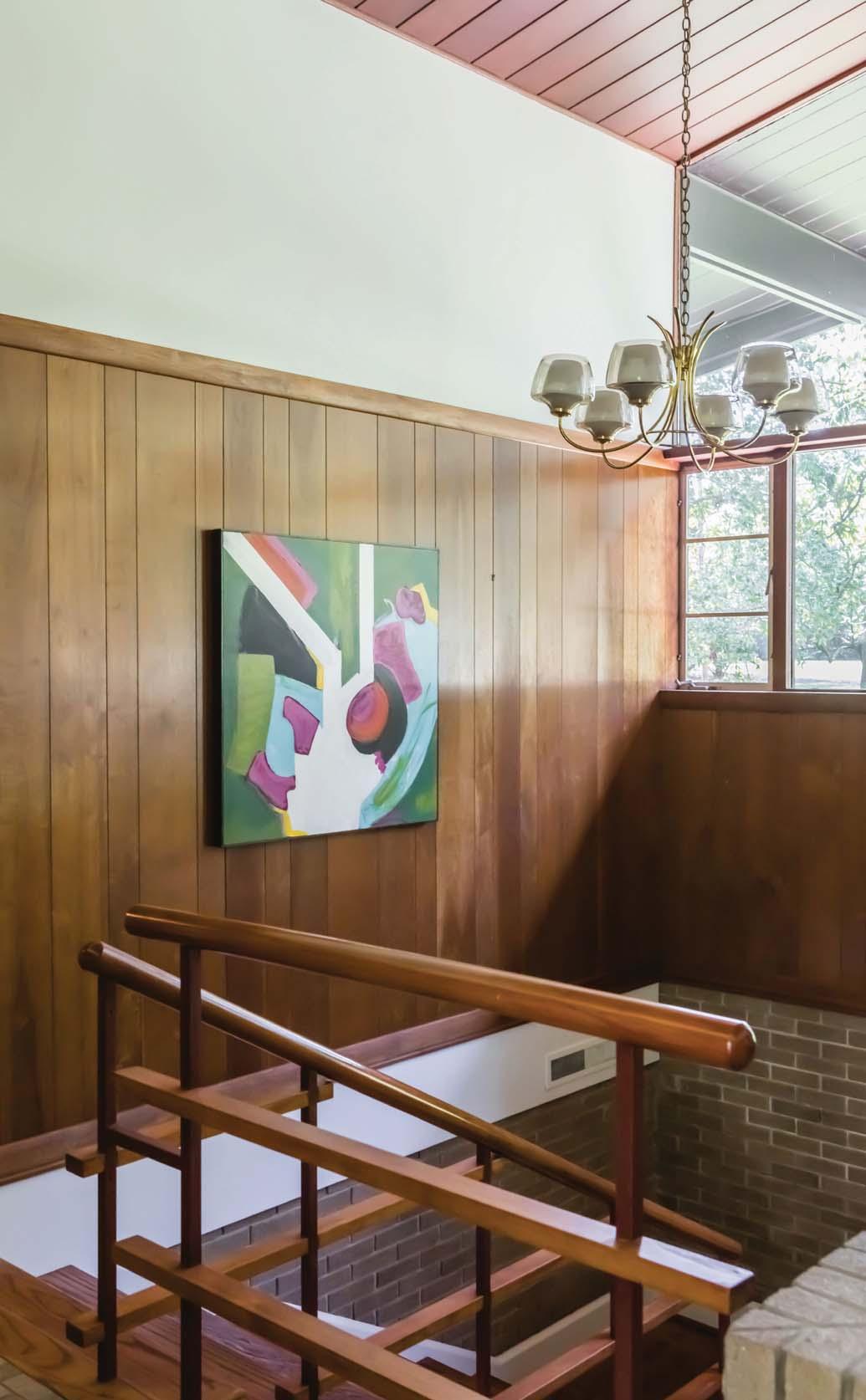

pactful appearances throughout, while flecks of gold and bronze complement ornate figurines Robbie Williams collected during her travels to the Far East. “I always like a little drama,” Williams says. “I tend to go a little traditional or transitional in style, but I also like Asian influences.” Though Todd Williams was mostly hands-off through the process, which took around seven months to complete, he did voice his opinion near the end as his wife was questioning some of the final touches. “He said, ask Tula, she’s always right!” laughs Robbie Williams. She says the home has been a blessing especially this year, a place of refuge in recent months during lockdown restrictions. “Every morning when I walk through the hallway and watch the light come in through the windows, I feel like I’m on vacation,” says Williams.
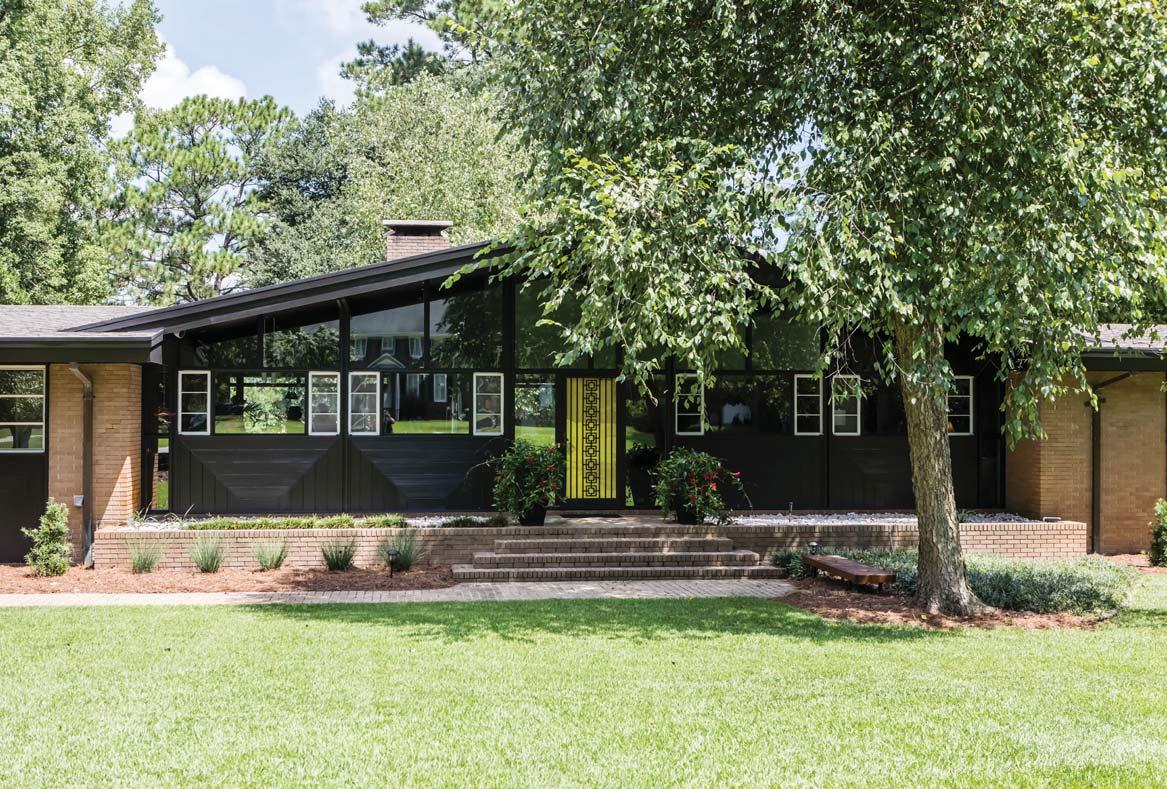
The front of the home is unassuming at first glance, but a deeper look offers a hint at the design-forward elements inside. The Williams family has spent much of their time in the back patio during coronavirus restrictions. The terraced back patio looks out to the pond and fire pit, and offers sweeping views of the property’s green spaces, like a private park where there is always something blooming. The couple built the fire pit near the pond to offer more dimension to the landscaping—and another private place to retreat and get away from it all.









